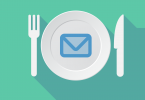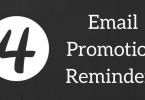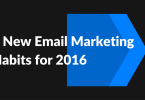
As a restaurant owner, you know what it’s like to be inundated with hundreds of emails a month.
Like all the rest of us, you archive in batches or choose to quickly delete uninteresting or unwanted emails. You know that you’ll only open emails if they catch your attention and you’ll only click on links if they’re adding value.
So why not send emails to your restaurant customers with that philosophy in mind?
 Your restaurant customers don’t want to read another spammy email urging them to come back to your restaurant with no clear reason why. In fact, they won’t even open that email unless that “reason why” is in the subject line.
Your restaurant customers don’t want to read another spammy email urging them to come back to your restaurant with no clear reason why. In fact, they won’t even open that email unless that “reason why” is in the subject line.
VentureBeat recently reported that email marketing offers the highest returns on investment. According to a study by MarketingSherpa, 91% of U.S. adults like to receive promotional emails from companies they do business with, especially when they carry deals or helpful information. In fact, 86%would like to receive promo emails at least monthly and 61 percent at least weekly.
This is not to say that email should replace all other forms of marketing. Email marketing, outbound ads, and social media can all be effective tools in your restaurant marketing arsenal.
However, think about the difference between “liking” a Facebook post and opting in to an email list. One is more indirect and impersonal, while the other indicates a sincere interest in learning more. People don’t regularly unsubscribe from newsletters, and if they opt in, that means they want your content.
For that reason, email actually converts more. According to a study by McKinsey and Company, email outperforms social in terms of conversion rates by 40X.
Maybe, just maybe, this means you should invest a bit more time into your restaurant email marketing strategy.
Start with growing your email list by using a restaurant POS system that collects customer data, or focus on increasing your organic reach. Then send emails that your restaurant customers actually want to read — and can’t wait to open.
Let’s focus on how to write this kind of email, from beginning to end. The truth is, while big restaurants may have entire departments devoted to marketing, many independent restaurants still leave some basic email marketing opportunities unfinished, leaving many opportunities on the table with their emails.
Anatomy of a Successful Restaurant Email Campaign
1. Reel in subscribers with a compelling welcome email.
It’s time to deliver on what you promised, right away. First, I recommend implementing a double opt-in. After a subscriber is added to your list, send them an automated email asking them to confirm their subscription.
In the copy of this email, include a call-to-action that makes this choice obvious. This will ensure that your subscribers are definitely interested in receiving your emails and will also automatically add your email address to their safe-sender list. The double opt-in easily possible to implement with popular email services such as Aweber and MailChimp.
After the double opt-in, now it’s time to send a welcome email, perhaps with an offer, thanking them for subscribing, whether that be a discount, or a gift card, or even a one-pager about your restaurant. Tell subscribers what they can expect from your email communications in terms of consistency and content, and get them psyched for their next email from you.
Here’s a great example from Boloco:
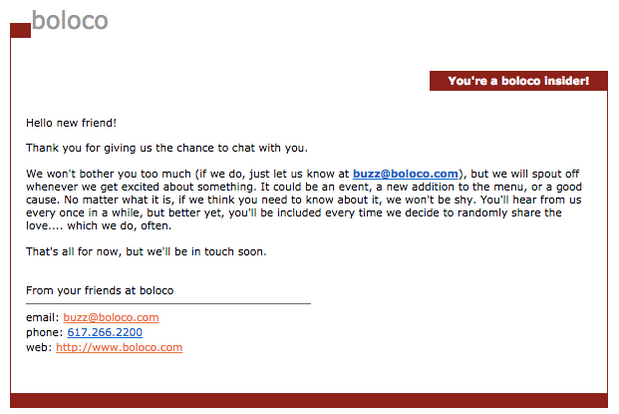
2. Craft captivating subject lines.
It all starts with that subject line. Arguably, it’s the most important part of your email; and it definitely determines whether your customer will be excited to open it. Here are some statistics about email subject lines that should help you when drafting them:
- 33% of email recipients open email based on subject line alone. (Source: Convince & Convert)
- 40% of emails are opened on mobile first – where the average mobile screen can only fit 4-7 words max. (Source: ContactMonkey)
- Emails with “Free” in the subject line were opened 10% more than those without. (Source: Sidekick)
- Click-through rate (CTR) is higher when using the recipient’s first name in the subject line over no use of the first name. (Source: HubSpot)
- Subject lines that create a sense of urgency and exclusivity can give a 22% higher open rate. (Source: Email Institute)
This data indicates that one-word subject lines, such as “Yum” or “Delish” might be very effective. Even a simple “Thank You” or “Hi there” could work if you’re just checking.
If you’re sharing a deal, “Quick — Free Quesadillas!” or a cute pun could be great ideas to promote offers. Head on over to step #3 to see some of my favorite subject lines.
3. Don’t forget the preview text.
Log into your inbox, especially if you’re a Gmail user. Do you see that gray text next to your email’s subject line? That’s the preview text.
Preview text mostly goes unused, so either you’ll see the first sentence of the email, or a URL there. However, sometimes email senders are clever about their preview text.
Check out this screenshot:
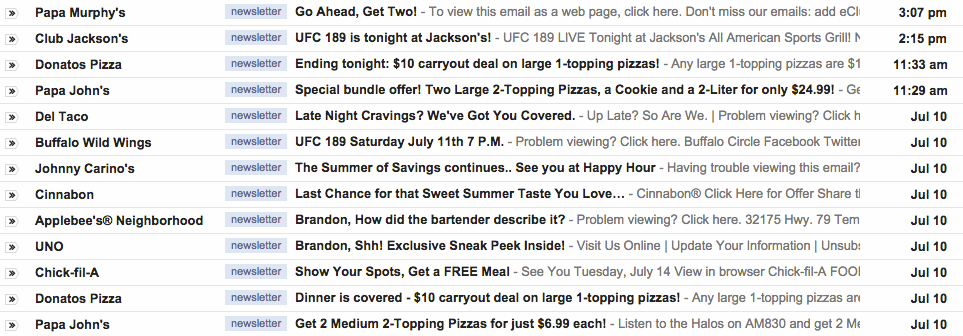
The preview text is your clever opportunity to tease what’s inside even more, to add a joke, or to add a few more information about your offer that will interest customers.
Don’t ignore it; using preview text to your advantage will set you apart from your competitors. And “Problem viewing” or “Having trouble viewing this email” doesn’t cut it!
4. Keep them simple, short and sweet.
Succinctness is the name of the game. OK, that’s a pretty long name, but I think you get the picture. Recently, I was checking out Email Design Inspiration and I came across this post pitting an email by P.F. Changs against an email by Prezzo.
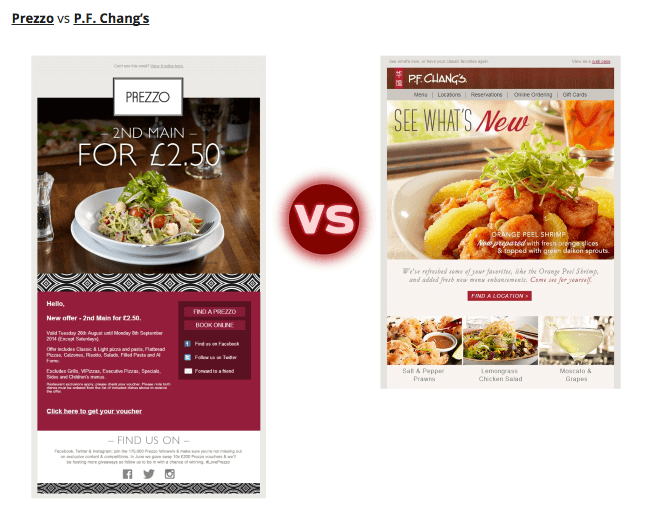
I voted for Prezzo because of its eye-catching design, but apparently P.F. Chang’s was leading with twice as many votes. Why? Because of its brevity. According to Adestra in 2015, 45% of email opens occurred on mobile, 36% on desktop and 19% in a webmail client.
When writing your emails, it’s important to imagine what your email will look like on smartphones or tablets. Limit the amount of buttons within the email, increase the amount of food pictures, and keep the copy light.
5. Reread your emails, and always ask, “So what?”
This is one of my favorite exercises.
It’s as simple as this: After you’ve written the body of your email, read it over, and ask, “So what?”
What will your customer be getting out of this? What’s the real value? Get specific, and edit the email to reflect your “so what.” There should be one main point in your email, especially if it’s an offer, and if there are more, one email may need to be chopped into several.
The “so what” should be abundantly clear the moment your customers read the subject line in your inbox.
6. Be creative with your email ideas.
Now, you don’t want every email you send to be an offer. Share restaurant news, press, and even interesting blog posts with email subscribers to get them interested.
Another idea is to share stories about local customers, or regulars, and why they love your restaurant. If you share customer stories, with their permission,you’ll be building a community around your restaurant brand. Very successful campaigns are also centered around a holiday.
Check out Fox Restaurant Concept’s quick but cute email that keeps their restaurant at top of mind for repeat customers:
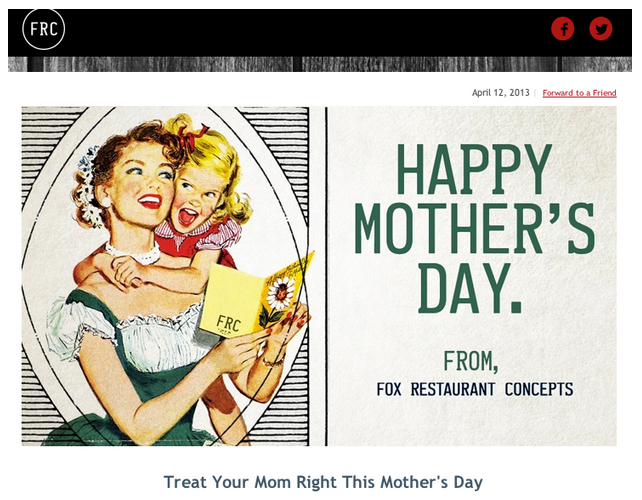
Storytelling is so important, even with email marketing, and you want these stories to reflect your restaurant’s core values.
7. Write in first person or second person when it makes sense.
This is a small change in copy that can make a big difference: Make emails come from one person, instead of from a company. When targeting offers, write in second person. When talking about your restaurant, write in first person.
First person: After much consideration, I’ve worked alongside the chefs to debut a new menu, full of locally-sourced food.
Second person: You’ll have to cheese it to believe it! 50% off quesadillas!
Even if the owner isn’t the one writing the emails, ghostwrite them so it sounds like he/she is. This allows for a more personal touch.
Your emails aren’t coming from a “brand,” they’re coming from an actual person, who actually cares. This will also encourage email replies, which can act as comments.
8. Give subscribers a taste for what’s coming next.
Many restaurant owners call their email list a “VIP club.” But it’s only a VIP club if you’re actually sharing VIP information.
Boloco calls their email subscribers “boloco insiders,” whereas Buffalo Wild Wings calls their email list “the inner circle.” It’s important that you live up to whatever title you choose to name your list or subscribers.
Send your subscribers cliffhangers about your restaurant. New menu? Tease it to the email list. New location? Let your email subscribers know before anyone else. Are your subscribers closing in on their loyalty rewards?
Inform them in a jam-packed email. Hiring new employees? Tell your email list to share with their friends and family, and give them a referral bonus. That’s when they’ll feel like VIPs at your restaurant.
9. Ask for input.
We’ve written about interactive email marketing before. Getting responses and engagements from your customers will make them want to continue to stay on your email list rather than hitting that dreaded “unsubscribe” button after 5 emails. Some popular poll questions you could ask:
- What is your favorite menu item?
- What do you like about the new design of our restaurant, and what do you dislike?
- What questions would you like to ask our chefs?
10. Send consistently, but not too often.
If, like a lot of independent restaurant owners, you don’t have time to send emails every couple weeks, it’s important that you at least stick to some sort of schedule.
I recommend sending monthly at first, and then increasing or decreasing frequency depending on your subscribers’ activity and your personal bandwidth.
However, don’t send too often. I quickly unsubscribed from this email list (not a restaurant’s, but similar – this one’s for travel deals) because I was getting emails every day and I had not signed up for that.
What is Your Restaurant Email Marketing Strategy?
When writing and sending emails to your restaurant customers, it’s important to keep these tips in mind. Share some examples of how you’re improving your restaurant email marketing below!



